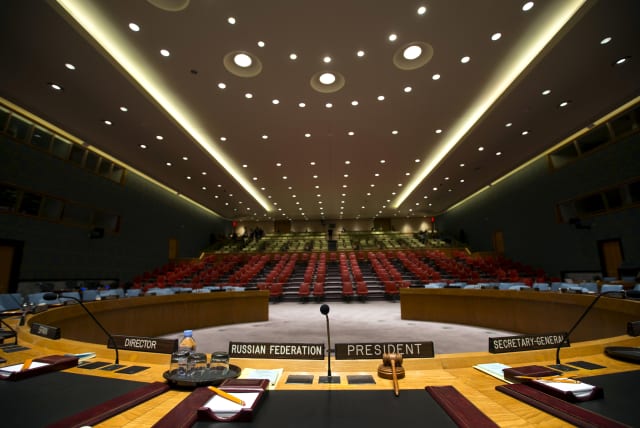UAE positions itself for UN Security Council presidency

The presidency of the security council is a rotating one-month position for the 15 members of the council; of which 10 are non-permanent members.
The UAE is assuming the presidency of the United Nations Security Council for a month, with The National reporting that the country will “host key events aimed at promoting peace in the Middle East.”
The presidency of the Security Council is a rotating one-month position for the 15 members of the council, of which 10 are non-permanent members. The United Arab Emirates currently holds a two-year position on the council. This move comes amid several developments in the Emirates and the region.
The UAE and United States just completed a key exercise called Iron Union 19, which took place in the UAE. According to Abu Dhabi state media, Maj.-Gen. Saeed Rashid Al Shehhi, commander of the UAE Land Forces, watched the joint UAE-US exercise.
“The joint exercise features military scenarios which aim to strengthen joint coordination and upgrade combat readiness. The exercise is part of the UAE Ministry of Defence’s strategy to raise combat readiness and build tactical proficiency,” WAM Emirates News Agency said.
According to reports from the US Air Force, a C-17 Globemaster III flew an M1A2 Abrams Main Battle Tank to the region as part of the drill. It was not clear what other assets were sent by the US for the drill.
The drill is an important part of the relations between the UAE and the US. It is also part of a larger footprint the US has in the region, including in Qatar, Kuwait and also US Central Command’s close ties to Israel, which have developed over the years.
CENTCOM head general Michael “Erik” Kurilla arrived in Israel this week for key meetings as well. UAE media highlighted this visit, discussing Israel’s Firm Hand drill, which is taking place this week. The UAE is keenly interested in US-Israel ties as they relate to its own partnerships with Israel and the US.
Meanwhile, Iran has indicated its hopes for increased ties with the UAE. Saudi Arabia, an indispensable partner of the UAE, recently reconciled with Iran – that means Iran is making more moves in the Gulf, including hosting Oman’s Sultan Haitham bin Tarik this week. As well, reports have come out claiming that the US and Iran are progressing on the nuclear issue, tying directly into the reduction of tension in the Gulf.
Iran’s Tasnim News, for instance, reported that Iranian Foreign Minister Hossein Amir-Abdollahian hailed the UAE as a reliable trade partner, saying cooperation could benefit the region.“Amir-Abdollahian highlighted the Iranian administration’s policy of developing ties with the neighbors,” the report reads. The Iranian regime media said that “the Emirati minister, for his part, highlighted the UAE’s determination to boost relations with Iran.”
This comes as reports at Al-Ain media in the UAE say the country is seeking to boost support for what is called the “blue economy,” which relates to the oceans in the region, and ties into fisheries and other economic aspects of the seas. This includes potentially the Gulf, the Gulf of Oman, the Red Sea and Eastern Mediterranean. A reduction in tensions in the region enabled this.
UAE withdrew from US-led Combined Maritime Force
According to Reuters, the UAE withdrew from the US-led Combined Maritime Force, a 34-country task force headquartered in Bahrain.
“As a result of our ongoing evaluation of effective security cooperation with all partners, two months ago, the UAE withdrew its participation in the Combined Maritime Forces,” the Ministry of Foreign Affairs said in a statement quoted by state news agency WAM.
According to Defense News, “CMF is a US-led naval partnership comprising 34 members, including Bahrain, Iraq, Jordan, Kuwait, Saudi Arabia and the United Arab Emirates. India, Djibouti, Kenya, and Oman are CMF partner nations. On average, there are six to eight vessels from contributing countries operating in support of the task force.”
The US also launched a new task force under the umbrella of the CMF on May 22. The new force will “train partner navies and improve operational capabilities to enhance maritime security in the Middle East. During a ceremony at US 5th Fleet headquarters in Bahrain, leaders commissioned Combined Task Force (CTF) 154. The new staff is CMF’s fifth task force after standing up CTF 153 in April 2022 for maritime security in the Red Sea,” the US said.
“CTF 154 will lead multinational maritime training at locations across the Middle East, enabling more CMF partner-nations to participate in training opportunities without ships or aircraft, particularly during courses that are facilitated ashore,” it added. This indicates the increased naval activity in the region, including by the US, UK, France and also joint work with South Korea, Japan and Italy.
Jerusalem Post Store
`; document.getElementById("linkPremium").innerHTML = cont; var divWithLink = document.getElementById("premium-link"); if (divWithLink !== null && divWithLink !== 'undefined') { divWithLink.style.border = "solid 1px #cb0f3e"; divWithLink.style.textAlign = "center"; divWithLink.style.marginBottom = "15px"; divWithLink.style.marginTop = "15px"; divWithLink.style.width = "100%"; divWithLink.style.backgroundColor = "#122952"; divWithLink.style.color = "#ffffff"; divWithLink.style.lineHeight = "1.5"; } } (function (v, i) { });

